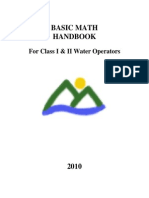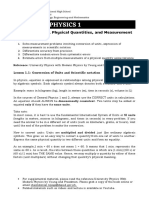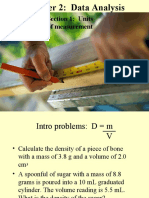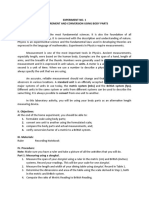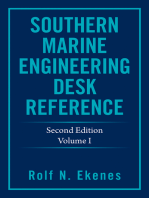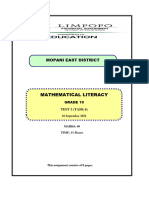Water Distribution Plumber I Sample Test Items
Water Distribution Plumber I Sample Test Items
Uploaded by
lesliedominguez431Copyright:
Available Formats
Water Distribution Plumber I Sample Test Items
Water Distribution Plumber I Sample Test Items
Uploaded by
lesliedominguez431Copyright
Available Formats
Share this document
Did you find this document useful?
Is this content inappropriate?
Copyright:
Available Formats
Water Distribution Plumber I Sample Test Items
Water Distribution Plumber I Sample Test Items
Uploaded by
lesliedominguez431Copyright:
Available Formats
Physical and Written
Employment Test Information
More information: ebmud.com/jobs/job-resources
Plumber 1 roles and responsibilities require qualified applicants to pass both a written and a physical skills-
based test for employment consideration. The percentage correct (or pass point) is not preset for written tests.
The number varies with each recruitment.
Physical testing – There are 5 components to the physical test. Candidates are required to pass all 5 physical test
stations in order to proceed to the hiring interview step.
Written testing – There are three major components of the written test – reading compression, math, and
mechanical/spatial ability. The questions below and attached answer key are from the Plumber 1 written test and
can be used as a study guide.
Section 1, Reading Comprehension which is made up of reading passages that you will interpret, apply or infer in
the corresponding question to measure your understanding, application and analysis skills. Success with reading
comprehension questions depends on your ability to obtain the answers from the reading selection and ability to
distinguish the best answer from several multiple-choice answers.
Use the passage below to answer the corresponding multiple-choice reading comprehension questions:
Passage 1: Ventilation, as used in fire-fighting operations, means opening a building or structure in which a fire is
burning to release the accumulated heat, smoke and gases. Lack of knowledge of principles of ventilation on the
part of firemen may result in unnecessary accidents due to ventilation being neglected or improperly handled.
While ventilation itself extinguishes no fires, when used in an intelligent manner, it allows firemen to get at the
fire more quickly, easily and with less danger and hardship.
1. According to the above paragraph, the most important result of failure to apply the principles of ventilation at a
fire may be:
a. loss of public confidence
b. disciplinary action
c. excessive use of equipment
d. injury to firemen
2. It may be inferred from the above paragraph that the chief advantage of ventilation is that it:
a. eliminates the need for breathing equipment
b. reduces smoke damage
c. permits firemen to work
d. cools the fire
Physical and Written
Employment Test Information
More information: ebmud.com/jobs/job-resources
Section 2, Math is made of problems requiring multiple steps to solve. You may be required to use combinations
of mathematical functions to solve a specific problem. Test answers are multiple choice.
Use the math information sheet below and sample math testing questions to answer the math questions below.
Use of noiseless calculators are allowed during the testing process.
Units and Conversion Factors Water Measurements
1 inch (in) (”) = 2.54 centimeters (cm)
1 gallon of water weighs 8.34 lb
1 yard = 3 feet (ft) (’) 1 L of water weighs 1,000 gm
1 yd3 = 27 ft3 1 mg/L = 1 ppm
1 meter (m) = 100 cm = 1,000 millimeters (mm) 1 grain per gallon (gpg) = 17.1 ppm
= 39.4” 1 atmosphere =
1 acre (a) = 43,560 square feet (ft2 ) 33.9 feet of water =
14.7 pounds/square inch (psi)
1 cubic foot (ft3 ) = 7.48 gallons (gal)
1 million gallons per day (MGD) = 1.55 cubic feet per
1 liter (L) = 1,000 milliliters (ml)
second (cfs)
1 gallon = 3.78 L = 3,780 ml 1 part per billion (ppb) = ppm/1,000
1 quart = .25 gallons
1 pound (lb) = 454 grams (gm) gpm = “gallons per minute”
1 ton = 2,000 lb
1 lb = 7,000 grains (gr)
1 gm = 1,000 milligrams (mg)
1 ppm = 1 part per million
Formulas for Calculating Angles, Volume and Areas
sides right triangle: a2 + b2 = c2
(a = side, b = side, c = long side (hypotenuse)
Interior angles of a triangle add up to 180˚
Interior angles of a quadrilateral (square, rectangle, trapezoid, etc.) add up to 360˚
area (A) of a rectangle: A = l·w (l = length, w = width)
volume (V) for a box: V = l·w·h (h = height)
area of a circle: A = π·r2 (π = 3.14, r = radius)
volume of a cylinder: V = π·r2 ·h, and can be expressed in in3 or ft3
volume of a cone: V = π·r2 ·1/3h, and can be expressed in in3 or ft3
π= 3.14; r = radius = diameter/2; h = height
Physical and Written
Employment Test Information
More information: ebmud.com/jobs/job-resources
1. If a customer used 15,200 cubic feet of water, and the District charges $3.00 for every 100 cubic feet, how
much will be charged for the water?
a. $45.60
b. $456.00
c. $4,560.00
d. $45,600.00
2. How many finished parts will a machine make in four hours if it makes six each hour?
a. 4
b. 6
c. 10
d. 24
3. What is the volume of a box measuring 10 feet by 80 inches by 1.5 yards?
a. 1,200 cubic feet
b. 1,200 cubic yards
c. 300 cubic feet
d. 300 cubic yards
Mechanical Ability/Spatial Concepts
Mechanical ability means that you can understand mechanical principles, devices, and tools, spatial relations, and
the everyday physics that make them work. These questions show you have the ability to reason and understand
the direction of movement of gears in a system of gears.
1. Which tank will hold the greatest amount of water?
Physical and Written
Employment Test Information
More information: ebmud.com/jobs/job-resources
Answer Key for Sample Questions
Answers to Reading Comprehension:
1. d.
2. c.
Answers to Math Problems:
1. b.
2. d.
3. c.
Answers to Mechanical Ability/Spatial Concepts:
1. d.
You might also like
- Pre ATPL Maths and Physics Revision Course-1Document23 pagesPre ATPL Maths and Physics Revision Course-1filzovoc91% (11)
- Grade 6 SIMOC 2018Document12 pagesGrade 6 SIMOC 2018Mehdi Moradi100% (4)
- Agricrops Exam With TosDocument3 pagesAgricrops Exam With TosMichelle Copones Llanes100% (11)
- SolidDocument3 pagesSolidKeziah Lynn Bautista0% (1)
- Grade - 10 Orientation PPT 2022-2023 NEWDocument100 pagesGrade - 10 Orientation PPT 2022-2023 NEWBHAVISHA BHATIANo ratings yet
- Unit Conversions PDFDocument21 pagesUnit Conversions PDFAhmad CakepNo ratings yet
- Sample Test Items Rev 08-07-19Document15 pagesSample Test Items Rev 08-07-19KomishinNo ratings yet
- Units measurement & Sig Figure. 2Document15 pagesUnits measurement & Sig Figure. 2Chitrakshi SinghNo ratings yet
- Basic Math HandbookDocument130 pagesBasic Math HandbookshanthiNo ratings yet
- Gen Phy 1 TCNHS Module 1Document4 pagesGen Phy 1 TCNHS Module 1Jasmine RamberNo ratings yet
- Dimensions, Unit Conversion and Basic Engineering CalculationsDocument15 pagesDimensions, Unit Conversion and Basic Engineering CalculationssarfaNo ratings yet
- Adm Math7 Quarter2 Module2 Revised Final-V2.0Document22 pagesAdm Math7 Quarter2 Module2 Revised Final-V2.0Jaylor Garido100% (2)
- Introduction To PhysicsDocument5 pagesIntroduction To PhysicsNephreteri Mae MaxinoNo ratings yet
- Advanced Math Handbook - Class III & IV Copy1Document101 pagesAdvanced Math Handbook - Class III & IV Copy1Ram CaceresNo ratings yet
- Unit 7Document4 pagesUnit 7Mora SestoNo ratings yet
- Answer Key PDFDocument199 pagesAnswer Key PDFEmilio José SelvaNo ratings yet
- Lesson 1 PhysicsDocument23 pagesLesson 1 PhysicsGen Z LearnersNo ratings yet
- Personal Tutor FinalDocument100 pagesPersonal Tutor Final신재호No ratings yet
- Module 1 Measurement Accuracy Precision and ErrorsDocument9 pagesModule 1 Measurement Accuracy Precision and ErrorsAbel CruzNo ratings yet
- A New Approach To I.C.S.E. Physics Part 1 For Class IxDocument135 pagesA New Approach To I.C.S.E. Physics Part 1 For Class Ixyash mahajanNo ratings yet
- Toaz - Info Performing Mensuration and Calculations Commonpdf PRDocument90 pagesToaz - Info Performing Mensuration and Calculations Commonpdf PRJay Ann AnggaosNo ratings yet
- Chapter 1 MaterialsDocument31 pagesChapter 1 MaterialsFahmi AmiNo ratings yet
- 1.1 PHYS 1 Chapter 1Document25 pages1.1 PHYS 1 Chapter 1Kmo 7No ratings yet
- Metric Handout Metric!: English System Metric System 1. Units of DistanceDocument4 pagesMetric Handout Metric!: English System Metric System 1. Units of DistanceSheehan Kayne De CardoNo ratings yet
- Week 3Document11 pagesWeek 3ARCELI ROBLENo ratings yet
- 02_CH01_Sec1.1-1.4 (1)Document27 pages02_CH01_Sec1.1-1.4 (1)ibrahimalhabsi118No ratings yet
- Bauchi State Civil ServiceDocument56 pagesBauchi State Civil Servicevictoromotega23No ratings yet
- Activity No 1.0 and 1.1 GEN - PHY1Document3 pagesActivity No 1.0 and 1.1 GEN - PHY1julietopayla95No ratings yet
- Reference: Section 2.7 Pre-Assignment: Read The "Why" Section and Do Question 1 Through 5 of The Activity. Why?Document8 pagesReference: Section 2.7 Pre-Assignment: Read The "Why" Section and Do Question 1 Through 5 of The Activity. Why?Mathew FreemanNo ratings yet
- CH 2 Data AnalysisDocument59 pagesCH 2 Data AnalysiseherrerahghsNo ratings yet
- Colegio de San Juan de Letran Calamba: School of Engineering and Architecture PHY081L - Physics LabDocument8 pagesColegio de San Juan de Letran Calamba: School of Engineering and Architecture PHY081L - Physics LabJonathan AysonNo ratings yet
- Perform CalculationsDocument170 pagesPerform CalculationsJM Llaban Ramos100% (1)
- Water and Wastewater FormulasDocument4 pagesWater and Wastewater FormulasarjmandquestNo ratings yet
- 10th Grade Physics - Unit 1Document25 pages10th Grade Physics - Unit 1Alice ScarletNo ratings yet
- Sample Question Paper Job 232Document7 pagesSample Question Paper Job 232VenuGopalNaiduNo ratings yet
- CH 2 Data AnalysisDocument50 pagesCH 2 Data AnalysiseherrerahghsNo ratings yet
- Basic Formula Water DemandsDocument4 pagesBasic Formula Water DemandsArfah MpNo ratings yet
- HW Packet Unit 1-17Document4 pagesHW Packet Unit 1-17api-368121935100% (1)
- Chapter 4 G8 Solved ExcerciseDocument9 pagesChapter 4 G8 Solved Excercisezainabshahzadi883No ratings yet
- General Physics 1 Measurement L - A 1Document30 pagesGeneral Physics 1 Measurement L - A 1Vea Patricia AngeloNo ratings yet
- Chap 1 ExcerciseDocument8 pagesChap 1 ExcerciseGreen Signal100% (2)
- 2Document42 pages2Nhu Nguyen0% (1)
- BL NurChem Activity 3 Measurement - REVISED 081920Document8 pagesBL NurChem Activity 3 Measurement - REVISED 081920Nur Fatima SanaaniNo ratings yet
- NF-15 - JT Chemical - Question PaperDocument13 pagesNF-15 - JT Chemical - Question Paperprasanthkola94No ratings yet
- (APFC) Answerkey For APFC 2012 MrunalDocument43 pages(APFC) Answerkey For APFC 2012 Mrunalkaranrag123No ratings yet
- Grade 6 - Physics Lesson - Week 1 1Document4 pagesGrade 6 - Physics Lesson - Week 1 1induraweetrathungaNo ratings yet
- Handout 1Document24 pagesHandout 1coppernitrateNo ratings yet
- Experiment 1Document2 pagesExperiment 1Yoonji MinNo ratings yet
- Chapter 1: Problems and Exercises: Openstax TutorDocument5 pagesChapter 1: Problems and Exercises: Openstax TutorRebecca LauNo ratings yet
- Chapter 1 - Introduction To Measurement (PHY400)Document27 pagesChapter 1 - Introduction To Measurement (PHY400)Anis NasuhaNo ratings yet
- HW1Document5 pagesHW1Petras PetricaNo ratings yet
- PDF Q0 3 Final Module SMAW 7 8Document20 pagesPDF Q0 3 Final Module SMAW 7 8ELIZABETH BUNIAONo ratings yet
- Introduction To PhysicsDocument30 pagesIntroduction To PhysicsHairul AkmalNo ratings yet
- Lab1 SampleDocument7 pagesLab1 Sampleruth ranselNo ratings yet
- ES 15 Module 1Document21 pagesES 15 Module 1Verenice FuentesNo ratings yet
- Southern Marine Engineering Desk Reference: Second Edition Volume IFrom EverandSouthern Marine Engineering Desk Reference: Second Edition Volume INo ratings yet
- Measurement of Length - Screw Gauge (Physics) Question BankFrom EverandMeasurement of Length - Screw Gauge (Physics) Question BankNo ratings yet
- ACT Math Section and SAT Math Level 2 Subject Test Practice Problems 2013 EditionFrom EverandACT Math Section and SAT Math Level 2 Subject Test Practice Problems 2013 EditionRating: 3 out of 5 stars3/5 (3)
- SAT Math Level 2 Subject Test Practice Problems 2013 EditionFrom EverandSAT Math Level 2 Subject Test Practice Problems 2013 EditionRating: 1 out of 5 stars1/5 (1)
- Integrals: Common Integrals Definite Integral DefinitionDocument1 pageIntegrals: Common Integrals Definite Integral DefinitionMark LunaNo ratings yet
- Problem Set 2 TopicsDocument1 pageProblem Set 2 TopicsGenesis Tolentino GonzalesNo ratings yet
- RS Aggarwal Solutions For Class 9 Maths Chapter 13 Volume and Surface Area 1Document86 pagesRS Aggarwal Solutions For Class 9 Maths Chapter 13 Volume and Surface Area 1souptikkarmakar7No ratings yet
- 2022 Mlit Test 3 QP Grade 10 Term 3Document8 pages2022 Mlit Test 3 QP Grade 10 Term 3roshlerdmaroshNo ratings yet
- 2019 Grade 4 Math Challenge Division Finals Questions and AnswersDocument2 pages2019 Grade 4 Math Challenge Division Finals Questions and AnswersJosephine Calapati100% (1)
- P6 ISMC 2019 Questions W AnswersDocument7 pagesP6 ISMC 2019 Questions W AnswersAileen Mimery100% (1)
- Questionaire Mathe 10 - MagNHSDocument13 pagesQuestionaire Mathe 10 - MagNHSDivine Grace VidalNo ratings yet
- Fourth Quarter Examination in Mathematics IVDocument2 pagesFourth Quarter Examination in Mathematics IVEdlyn KayNo ratings yet
- CAPE Ques & Ans Info.Document72 pagesCAPE Ques & Ans Info.Stefon SkeeteNo ratings yet
- ISMC 2016 Primary 4 QuestionsDocument8 pagesISMC 2016 Primary 4 QuestionsAileen Mimery100% (1)
- 20mid0116 VL2020210104677 Ast02Document10 pages20mid0116 VL2020210104677 Ast02Mrunalini ReddyNo ratings yet
- Hedge Height SpreadsheetDocument5 pagesHedge Height Spreadsheetgharavii2063No ratings yet
- Math ProjectDocument14 pagesMath Projectammarrosdan123No ratings yet
- Secondary 2: Asia International Mathematical Olympiad UnionDocument4 pagesSecondary 2: Asia International Mathematical Olympiad UnionNguyen MinhThanhNo ratings yet
- Grade 9 Midterm Revision Material Paper 2 (Set A)Document9 pagesGrade 9 Midterm Revision Material Paper 2 (Set A)yến ngô hảiNo ratings yet
- Chapter 4 Numerical Differentiation and IntegrationDocument110 pagesChapter 4 Numerical Differentiation and IntegrationKaplan yuNo ratings yet
- 2014 Kcse Mathematics MsDocument49 pages2014 Kcse Mathematics MsjosephwachiragatuaNo ratings yet
- F6 Math 2014 1sttest Question BookDocument2 pagesF6 Math 2014 1sttest Question BookUniversityJCNo ratings yet
- Chpter 4Document25 pagesChpter 4jermynNo ratings yet
- 9 WorksheetDocument2 pages9 Worksheetshankarrohit057No ratings yet
- Year 9 PSMTDocument5 pagesYear 9 PSMTllaza200814No ratings yet
- ConArts 4thQDocument92 pagesConArts 4thQSandraNo ratings yet
- 4024 w19 QP 22 PDFDocument20 pages4024 w19 QP 22 PDFhamnaNo ratings yet
- Computer Science 8 - 2ND QuarterDocument9 pagesComputer Science 8 - 2ND QuarterBERLYN LOLONG MAGSINONo ratings yet
- LANDSectionsand Measures 2Document1 pageLANDSectionsand Measures 2msd6924No ratings yet
- MyPractice - Question BankDocument30 pagesMyPractice - Question Banklinfrank272008No ratings yet









